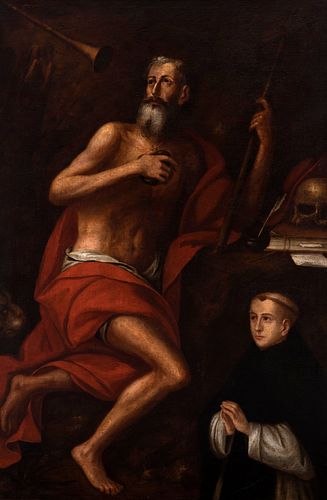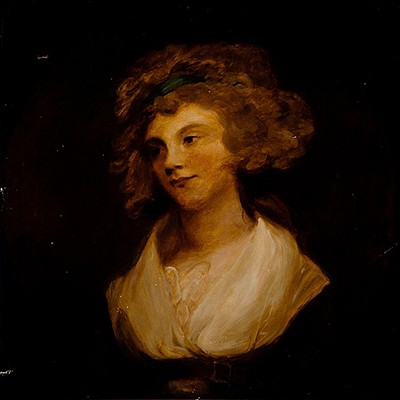Spanish school of the mid-seventeenth century. "St. Jerome penitent with Dominican donor". Oil on canvas. Relined.
About Seller
Carrer Aragó 346
Barcelona
Spain
Setdart Subastas was born in 2004 and is currently the first online art auction in Spain with solidity, prestige and reliability guaranteed by our more than 60,000 users. Setdart has a young, dynamic and enterprising team ready to successfully manage the purchase and sale of art works through custom...Read more
Two ways to bid:
- Leave a max absentee bid and the platform will bid on your behalf up to your maximum bid during the live auction.
- Bid live during the auction and your bids will be submitted real-time to the auctioneer.
Bid Increments
| Price | Bid Increment |
|---|---|
| EUR€0 | EUR€10 |
| EUR€200 | EUR€25 |
| EUR€500 | EUR€50 |
| EUR€1,000 | EUR€100 |
| EUR€3,000 | EUR€200 |
| EUR€5,000 | EUR€500 |
| EUR€10,000 | EUR€1,000 |
| EUR€20,000 | EUR€2,000 |
| EUR€50,000 | EUR€5,000 |
About Auction
Nov 25, 2021
Setdart Auction House sofia@setdart.com
- Lot Description
Spanish school of the mid-seventeenth century. "St. Jerome penitent with Dominican donor". Oil on canvas. Relined. With inscription on the canvas indicating the collection it belonged to. Restored work. With repainting and patches. Measurements: 167 x 109,5 cm; 183,5 x 126,5 cm (frame). In this work the painter offers us an image full of mystical emotion, very typical of the Spanish Counter-Reformation art. Thus, we see a work of clear and concise composition, with the saint full-length in the foreground, highlighted by direct lighting, tenebrist, on a background of dark tones. As was also common at this time in the Spanish school, Saint Jerome is shown writing and meditating next to a human skull. Next to the saint, other iconographic attributes that define the figure of St. Jerome can be appreciated, first of all, the lion that accompanied him since he took the thorn out of the silver, and also the scriptures that define him as the first translator of the Bible. In this scene he is listening to the trumpet blast that is to summon the dead on Judgment Day. In the lower right part, the artist has represented the donor of the painting, a Dominican friar praying before the saint. One of the four great Doctors of the Latin Church, St. Jerome was born near Aquileia (Italy) in 347. Trained in Rome, he was an accomplished rhetorician and polyglot. Baptized at the age of nineteen, between 375 and 378 he retired to the Syrian desert to lead an anchorite's life. He returned to Rome in 382 and became a collaborator of Pope Damasus. One of the most frequent representations of this saint is his penance in the desert. His attributes are the stone he uses to beat his chest and the skull on which he meditates. Also the cardinal's cape (or a red mantle), although he was never a cardinal, and the tamed lion. The latter comes from a story of the "Golden Legend", where it is narrated that one day, when he was explaining the Bible to the monks of his convent, he saw a lion coming with a limp. He removed the thorn from its paw, and from then on he kept it in his service, instructing it to look after his donkey while it grazed. Some merchants stole the donkey, and the lion recovered it, returning it to the saint without hurting the animal. Spanish Baroque painting is one of the most authentic and personal examples of art, because its conception and form of expression arose from the people and the deepest feelings that nestled in it. With the economy of the State broken, the nobility in decline and the high clergy burdened with heavy taxes, it was the monasteries, parishes and confraternities of clerics and laymen who promoted its development, the works sometimes being financed by popular subscription. Sculpture was thus compelled to embody the prevailing ideals in these environments, which were none other than religious ones, at a time when the counter-reformist doctrine demanded from art a realistic language so that the faithful would understand and identify with what was represented, and an expression endowed with an intense emotional content to increase the fervor and devotion of the people. The religious subject is, therefore, the preferred theme of Spanish painting of this period, which in the first decades of the century starts from a priority interest in capturing the natural, to progressively intensify throughout the century the expression of expressive values, which is achieved through the movement and variety of gestures, the use of light resources and the representation of moods and feelings.
Dimensions:
INV Number:
167 x 109,5 cm; 183,5 x 126,5 cm (frame).
35256567 - Shipping Info
-
In-house shipping available. Please inquire at admin@setdart.com.
-
- Buyer's Premium



 EUR
EUR CAD
CAD AUD
AUD GBP
GBP MXN
MXN HKD
HKD CNY
CNY MYR
MYR SEK
SEK SGD
SGD CHF
CHF THB
THB
















